It is no secret that our society would have a hard time operating without some type of fuel source. Whether your vehicle runs on ethanol or gasoline, you would be out of luck if something happened to the nation’s fuel supply.
This is why it can be a great idea to learn how to create your own fuel source at home. You never know when you will need it.
You may be wondering how on earth you are supposed to make your own fuel source; after all, you do not have a drill, and you do not know where any underground oil fields are anyways. Luckily, you can make your own fuel source using just a few simple ingredients.
Related: The Best Places Where You Can Store Fuels Safely In An Emergency
Keep in mind that this method will only produce a small amount of fuel. If you want to produce on a larger scale, you will need to invest in extra storage space.
Supplies
To start with, you will need to make sure that you have all of your ingredients and supplies to make this fuel source.
Luckily, there are only three ingredients used in this particular method of creating your own fuel source. This means that it is great for beginners and easy to do.
Here is a list of the ingredients and supplies that you will need:
- Oils or fats: This ingredient can be taken either from animals or plants. Any type of oils or fats can be purchased at your local store, or you can research how to make your own from kitchen waste.
⇒ How To Make Lard, The Ultimate Survival Food
- Alcohol is an important ingredient in this fuel source, and can also be purchased from any local store. Methanol is usually the safer choice and great for beginners, but you can also learn how to make your own still and extract your own ethyl alcohol.
- Chemicals: You can either opt for potassium hydroxide or sodium hydroxide for this ingredient.
- Measuring Cup: This will be used to measure your oil. Make sure that your measuring cup is large enough to measure out at least a liter of oil.
- A pan that will be used to heat your oil. You will also need a source of heat such as a stove or a burner.
- Thermometer: This will be used to ensure that your oil is at a high enough heat before combining the ingredients.
Now that we have all of our supplies and ingredients, it is time to get started!
Directions:
1. Start by measuring out 500 ml of the oil of your choice and pouring it into your pan.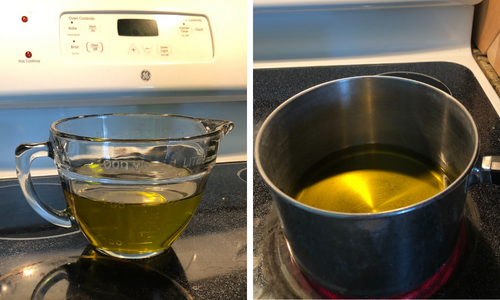
Turn on your heat and make sure that you have a thermometer handy to observe the temperature of your oil. After the oil has begun heating, you can move on to the second step.
Related: How To Make Fuel From Birch
2. For this step, measure out 100 ml of methanol.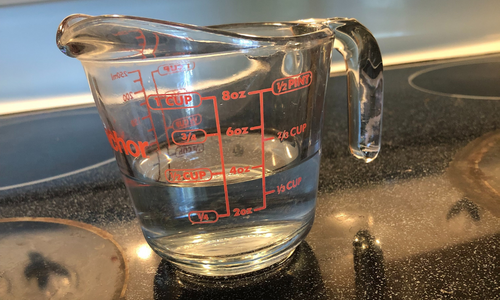
3. Depending on which type of chemical you decided to go with, you will need to measure the correct amount for this fuel recipe to work.
If you have potassium hydroxide, you will need 3.5 grams; if you have sodium hydroxide, you will need 2.8 grams.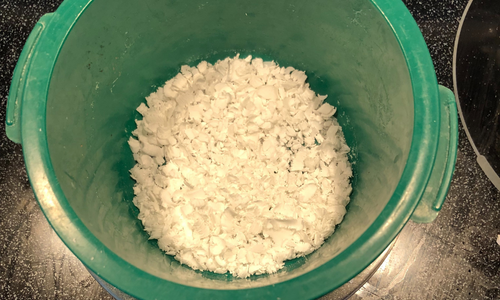
When you have the correct amount of chemical measured out, you will need to add it to the methanol that we measured in the previous step.
Related: What’s The Best Fuel To Stockpile For Survival?
Simply pour in the chemical and stir until dissolved. This should take no more than 10 or 15 minutes.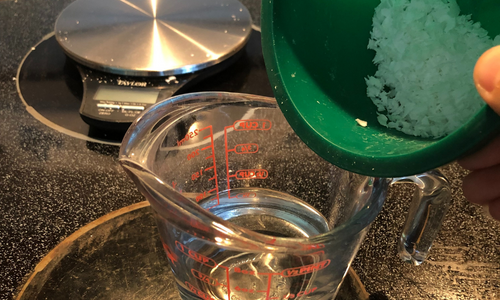
Use this time to check the temperature of your oil. The ideal temperature for your oil is 130 degrees F. When you reach this temperature, it is time for the next step!
4. It’s time to combine the ingredients in a separate container. Using a funnel, pour your hot oil into a mixing container such as a glass jar. Remember that this oil will be hot, and can burn you, so use extra precautions during the pouring process.
When your hot oil is safely in the mixing container, it is time to pour your chemical/ methanol solution into the oil. Seal the mixing container as tightly as possible and shake this mixture for at least five minutes.
You may notice the mixture changing colors throughout the shaking process; this is normal.
⇒ How To Produce Your Own Electricity At A Low Cost
5. After you are done shaking your mixture, find somewhere safe to set your jar and let it set uninterrupted for around 24 hours.
When you come back the next day, you should notice that your mixture looks a little different than it did the day before. Again, this is normal!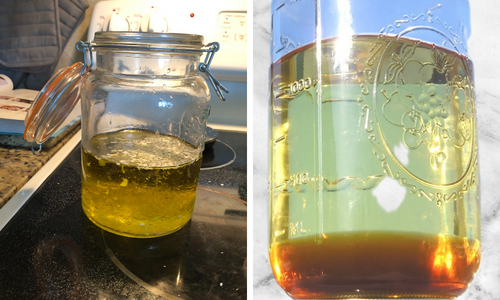
Your mixture should be separated into three distinct layers. The top layer should be clear and is the desired biodiesel.
The middle layer is a little more cloudy; this is the glycerin. If you have set the jar in a colder area, you may notice a third layer that is actually the biodiesel gelling.
6. Gently pour out the top layer of biodiesel from your mixture, being careful not to pour out any of the glycerin. Set your jar back in its safe place and let it sit for a few more days. Your mixture should slowly become more and more clear until you can see through it.
Now that you have completed all of the steps, you are left with your very own biodiesel that can be used freely for any small machines that you have around your property. It can also be used to fill up any oil lamps that you have lying around.
Not only is biodiesel easy to make by yourself in small batches, but it is also much better for the environment. Since it is made from plant oils usually, it is considered a renewable alternative to regular diesel.
Not only that, but it is better for emissions and for the environment. It is more easily cleaned up in the case of a spill, and it is also far less combustible than normal diesel.

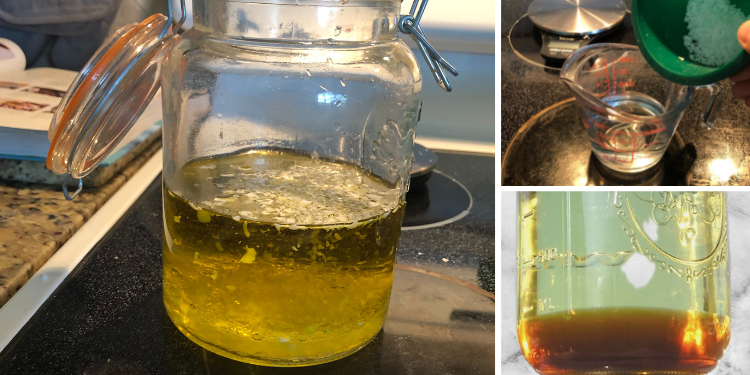













Should be titled, “How to make your own diesel fuel”.
No, it should be “How to Blow up Your House!”
I’m confused…you said this will separate into 3 layers, the top being biodiesel, 2nd layer glycerin and 3rd biodiesel gelling. Step 6 says to pour off the top layer of glycerin. So is the top layer glycerin or diesel?
Time to re-read step 6.
Um Dan it says to pour out the top layer of biodiesel being careful not to pour out the glycerin (the second layer) with the top layer (the biodiesel) meaning try not to mix the two when pouring out the top layer (the biodiesel) Stop pouring when you reach the 2nd layer the glycerin.
Top layer is biodiesel
2nd layer or middle layer is glycerin until it turns over the days
Got it now ?
The top layer is the fuel. Then followed by glycerin and the bottom is actually soap. If you screw it up, you usually end up with a lot of soap. What you are doing is separating the esters from the oil.
If you end up making a bucket or jar of soap at first don’t be discouraged. It will be some of the best de-greaser you ever had and you also know how to make soap now.
Using clean oil is pretty easy going. Using fryer oil and animal oils takes some calculation. You need to use the proper amount of catalyst to successfully draw all available esters out of the oil. Get on the intergoogler. There is a wealth of info on making a proper reactor and how to calculate the proper amount of catalyst.
Yes I was confused likewise !
Can it be used in a car???
This is basically Diesel and can only be used in Diesel motors. If you live in a cold region you will need a inline or tank attached heater to prevent gelling. Google to find methods for high volume production. The volume here is useless as a fuel , but demonstrates the process. When this process first become popular you could get used grease from restaurants for free, but now their used oil is in locked storage and sold to biodiesel processors, making this process pretty much useless.
Uses for the glycerin? And the biodiesel gel?
Dear Kyle, the importance of this tutorials is life-or-death.
Please do elaborate. Please expand on this ideas. Will really appreciate any depth or further comments. The question from mr Tanner is so important! Thank you.
Locally we had a restaurant owner running his older Mercedies diesel car with used fryer oil from his restaurants. We used to laugh about the French fry Mercedies. He’d laugh with us at the local coffee shop.
He simply filtered it for the debris and ran it 50-50 with regular diesel. Otherwise, as he explained it was too thick to properly burn in the car.
You can also use used veggie oil-diesel mix in a waste oil heater. His restaurant supply building was so heated.
Doing the biodiesel processing eliminates the glycerin in the cooking oils, but there is what do you do with the glycerin and residue with the caustics you added.
He stopped doing this during COVID due to less used deep fry oil being available and even today diesel is cheaper than fry oil per gallon.
Just be aware that modern diesel cars are likely to have issues with raw oil being mixed in with diesel, and also with this less complex method due to the presence of dissolved glycerin and other by-products. To use home-made biodiesel in anything but older, clunkier car engines there are additional steps by which you quite literally ‘wash’ the diesel and these are iterated a couple of times. Also, just note that glycerin can be used to produce liquid soap, so all parts of the diesel process can be utilised.
Corn produces 300 gallons per acre.Jerusalem Artichokes produces 600 gallons per acre of alcohol fuel.
Like your books.
lol it also requires a lot more then just harvesting..
Holy cow!!! I wonder how cultivable they would be in these lands (northwestern southAmerica). Would love some info on that. Thanks for your apport.
You underestimate human ingenuity. down here in southamerica people “cook” advanced chemicals in the most filthiest, amateurish hardware and procedures. Lets make that biopower!
Before the SHTF I’d recommend learning how 2 and four stroke engines actually work and why. (Certified Michigan Mechanic)
Experiment with a carbonated engine vs modern computer fuel injection. If you don’t know the difference… look it up. (Hint chain saws, lawn mowers, weed whips are carbonated)
Octane, diesel, corn ethanol vs sugar cane ethanol, fuel additives, etc. all put out a different power level based on how the engine was designed.
Observation: when you buy cheater gas, which has up to 10% ethanol, you will notice your gas mileage drops. Ethanol is not as combustible as pure gasoline (I like North Dakota where the pumps say “no ethanol”- best gas mileage I’ve ever gotten!)
It’s a scam. Ethanol has 2/3 the BTU energy as the same volume of gasoline. They thin out gasoline with it which reduces overall mileage while simultaneously increasing the price. Scam.
This requires some purchased products so or at least some difficult products to produce or get, later on in a shft scenario this would be useless and as has been said this will most likely ruin your engine or cause mechanical issues.
Opening with engine running of gas or alcohol, then making diesel, The title and the opening paragraph need attention or an explanation of using diesel in gas or alcohol engine.
Tel what you can do with the glycerin as well.
Thanks for the article, it’s getting the ol gears turning. I haven’t really put much thought in making biodiesel…and my Humvee will run on it!
Why would anyone buy a hunvee
Lol only the rich think they need a Hummer. Why because only the rich can afford the fuel and maintenance for it. Driving any vehicle around after a shtf that is expensive will draw a lot of unwanted attention.
There is other fuel you can use and make that is much easier. In the early 1900s farmers used wood as fuel and it was not using steam.
Look up this on Wikipedia
This requires some material to build and time but it is do able and has been done by preppers’
Agree dreaded. damn Hummer, those are a waste, for the 1% !
HumVEE! Most capable for the $$. Get the surplus while you can…or not. Gets me through the river and over 60% grade hills, to go see grammaw, lol!!!
This artical is a waste of time.
If things have gone to hell to the point that fuel is not available I doubt that enough hydroxides and fats will be around to make a meaningful difference.GET IT FROM YOUR LOCAL STORE, RIGHT!!!! You are going to be too busy surviving to have time to worry about motor fuels.
If a couple hundred gallons of stockpiled fuel is not enough for a crisis we are truly screwed.
Biodiesel not to be used in gasoline vehicles. E-85 is a lot easier and most areas have tons of fallen fruit, grain being harvested and so on. After cook off, any solids are considered high protein etable (yeast). If feeding to livestock, no more than 10% because it’s equal to meat. Ask the county ag rep about a license, they used to be free. Always use a separate building and make it strong, break-in proof. This makes the feds happier. niio
Why would anyone care what the feds think
How to process wood ash to get the lye needed?
A wood gasifier will power many different engines.
Absolutely right Chuck but how many people even know how to make a wood gassifier. Did I hear someone say just cook the wood? Keerect! When you throw a piece of wood on the fire and see those jets of flame that’s the wood gas burning off. Charcoal is just “clean” wood. They cook the wood in an anaerobic environment to burn off all the impurities and wood gas so that all you’re left with is the carbon. I’ve never generated wood gas but I figure it’s more or less the same process. You may even end up with some usable charcoal. You heat the wood until the wood gas starts to flow. Capture the gas. Modify your carburetor. Pipe in the gas.
Am trying to locate the link for downloading some ebooks that I have purchase back in June Y2022. Hope I could get some assistance herein at the earliest.
Hi Folks
Unrelated subject here but I have a question for you. If you wanted to bury some valuables and they are sensitive to moisture what is your best plan? I know about oxygen absorbers and desiccants and such but they don’t seem to me to a long term thing. I had an idea that if you could actually wire a small heat rod up to a small solar panel and hide that panel well it would take some worries out of rust and mildew and the likes. Any thoughts on this?
TomNass
You could use a old army can they can be water proof and maybe moisture proof as well.. good luck
I’d like to gear more thank you
I wonder if anyone who is looking for alternative fuel sources has considered Bio-gas. Its basically methane collected from, you guessed it, human waste/sewerage. It can be added to with animal manures, and China has recommended and in fact supports remote villages in producing this for themselves (Cheaper than getting mains gas or LPG in to some places). Then you need appliances with jets adjusted to use methane and Bob’s your Uncle – fuel from waste. I am supposing that, with the use of a a compressor – it could be bottled for transport too.